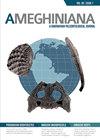印度中部Wardha盆地下Talchir组的上宾夕法尼亚时代——基于南美洲、非洲和澳大利亚辐射定年孢粉带中的Guide孢粉形态
IF 1.5
4区 地球科学
Q3 PALEONTOLOGY
引用次数: 3
摘要
摘要根据在印度冈瓦纳(Gondwana)产生的孢粉地层资料和放射性测年资料,修正了对应于冈瓦纳(二叠纪-石炭系)层序下部的Talchir组的年龄。新数据来自于位于Wardha Valley煤田(Maharashtra邦,印度中部)Penganga地区的131井Talchir组的7个样本。根据63种孢子(23个分类群)、花粉粒(35个分类群)和浮游植物的地层分布划分出两个组合。在两个基样中发现孢粉结合力产生少量点孢孢子和单糖花粉粒。孢粉结合体II在上覆的三个样品中划分,其孢子和花粉粒比其他两个样品更多样化和丰富。几个分类群(concavisimisporites grumulus, Converrucosisporites confluens, Cyclogranisporites gondwanensis, Verrucosisporites andersonii, Latusipollenites quadrisaccatus, Marsupipollenites striatus, Pakhapites fusus, Striatoabieites multistriatus, Vittatina subsacata, Vittatina vittifera)与辐射测定限制在阿根廷,巴西,非洲和澳大利亚的最新宾夕法尼亚-早期cisurian的孢粉带共享。因此,我们提出了Talchir组孢粉组合I和II的Kasimovian - ghezian - asselian年龄,并分别与Tiwari和Tripathi的Potonieisporites忽视带和Plicatipollenites gondwanensis带进行了对比。该方法显著提高了冈瓦纳地区印度孢粉带的地层相关性。本文章由计算机程序翻译,如有差异,请以英文原文为准。
Upper Pennsylvanian Age of the Lower Talchir Formation in the Wardha Basin, Central India, Based on Guide Palynomorphs Present in Radiometrically-Dated Palynozonations in South America, Africa, and Australia
Abstract. The age of the Talchir Formation corresponding to the lower part of the Gondwana (Permo–Carboniferous) Sequence in India is revised in the light of palynostratigraphic data associated with radiometric dating generated in Gondwana. New data was generated from seven samples of the Talchir Formation obtained from Well 131, located in the Penganga area of Wardha Valley Coalfield (Maharashtra State, central India). Two assemblages were demarcated based on the stratigraphic distribution of 63 species of spores (23 taxa), pollen grains (35 taxa), and phytoplankton. Palynoassociation I recognized in the two basal samples yielded few Punctatisporites spores and monosaccate pollen grains. Palynoassociation II is demarcated in the overlying three samples characterized by spores and pollen grains that are more diversified and abundant than in the other two samples. Several taxa (Concavissimisporites grumulus, Converrucosisporites confluens, Cyclogranisporites gondwanensis, Verrucosisporites andersonii, Latusipollenites quadrisaccatus, Marsupipollenites striatus, Pakhapites fusus, Striatoabieites multistriatus, Vittatina subsaccata, Vittatina vittifera) are shared with palynozones radiometrically constrained to the latest Pennsylvanian–early Cisuralian in Argentina, Brazil, Africa, and Australia. Therefore, we propose a Kasimovian to Ghezelian–Asselian age for the palynoassociations I and II of the Talchir Formation and a correlation with the Potonieisporites neglectus and Plicatipollenites gondwanensis Zones of Tiwari & Tripathi, respectively. This approach significantly improves the stratigraphic correlations of the Indian palynozones in Gondwana.
求助全文
通过发布文献求助,成功后即可免费获取论文全文。
去求助
来源期刊

Ameghiniana
地学-古生物学
CiteScore
2.50
自引率
10.00%
发文量
21
期刊介绍:
Ameghiniana is a bimonthly journal that publishes original contributions on all disciplines related to paleontology, with a special focus on the paleontology of Gondwana and the biotic history of the southern hemisphere. Published yearly since 1957, it has undoubtedly become the main palaeontological publication from Latin America. Ameghiniana has recently broadened its editorial board, reorganized its production process, and increased to a bimonthly frequency, which resulted in a significant decrease in the turn around time.
 求助内容:
求助内容: 应助结果提醒方式:
应助结果提醒方式:


